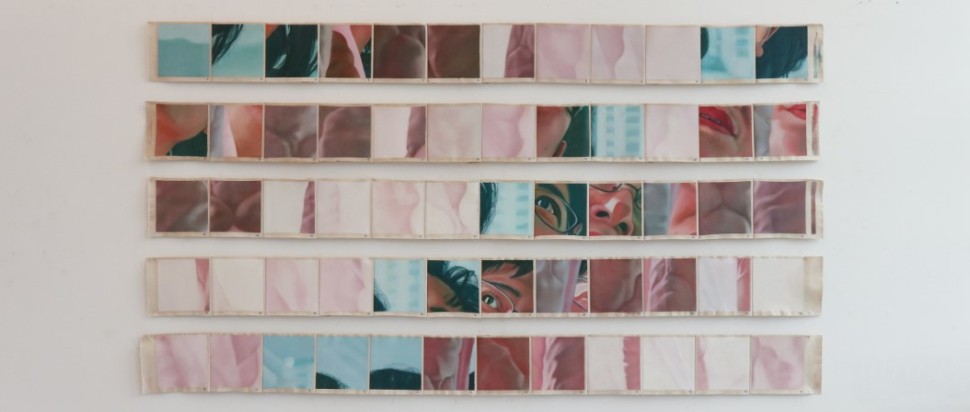GSA Degree Show 2023: Master of Fine Art
2023's graduating MFA class from Glasgow School of Art share an interest in the personal and experiential, and the wider cultural intersections of the two
Pushing the material potential of mediums (whether organic, found, analogue or digital), research, investigation and theoretical thought form an integral part of the MFA graduates' practices. The old school building on the south bank of the Clyde which hosts the MFA Degree Show offers varied spaces for graduating students to exhibit work, including in the retired science laboratory, or suspended in the central stairwell.
Hayden Judd has stitched together a ten-metre sail by hand, using techniques learned from specialists. It repurposes discarded fabrics collected from sailmakers in South Queensferry and Ardrossan. Through researching historical industry based around the Clyde, notably shipbuilding in Partick, Hayden has learnt about his own family’s connection to nautical activity. A hierarchy of labour is mapped out, as a symbolic family tree, with ancestors’ names listed alongside their role – “first mate”, “fisherman”, “diver”, and lastly, Hayden establishes himself as “unskilled worker”. The making process imperfections reflect Hayden’s distance from a simultaneously individual and wider local history.
Historical investigation is also central to Chih-Kang Hsu’s practice. Chih-Kang has constructed a monument from cast bricks, fixing a white board where a plaque would ordinarily sit. Viewers are invited to write on the board, naming the monument. In turn, the spectator is dually involved as a narrator, questioning the established notions of memory and truth – who gets to write history? The subtle agitation in Chih-Kang’s work is reflected in the physical process of his photography, in which the past is tampered with; photographs are cut into and scratched away.
Ritu Arya’s tangential making process reflects the transitional nature of her practice; working with photography previously, and now primarily using clay, she explores material reacting to tension. Ritu crafts bodily clay forms that deal with the physicality of “untended trauma” observed personally, and in everyday life. Ritu’s writing describes an ache that is “more destructive with each trigger” and asks, “What does it taste like?” The internal and sensory are portrayed in the clay’s varied states; some raw, and others fired, or glazed in Jesmonite. Ritu materialises disruption, in the use of ferrofluid and magnets that respond to a room’s movement.
Nanjoo Lee uses painting as a vehicle for translation, embracing the imperfections that are inevitable to recreating an image. In Translating Practice, Nanjoo makes sense of the disorder and beauty involved in understanding a relationship. A photograph of Nanjoo’s mother is split into 60 numbered squares, and ordered in rows to create a cinematic, unreliable chronology. In Nanjoo’s video work, soap is a metaphor, used to critique stereotypes surrounding women in domestic settings. The imagery is intimate and evocative, whilst asking wider questions about labour, allowing us to consider our own close relationships.
Phyllis Mcgowan’s work with film, narration and writing similarly explores the complexity of communication. The spoken text piece, Dear Christina, is self-referential, and speaks on what the audience can and cannot know, as Phyllis reads an email aloud written to an unknown receiver. The sea is a recurring backdrop in Phyllis' work; using found footage of women on the beach, or as projection, from the perspective of a swimmer. Thinking in Shapes narrates Phyllis’ relationship to her mother, presenting non-linear autobiography as thoughts that must be externalised in surreal, poetic, rhythmic form.
A viewer first begins to understand James Epps’ installation by stepping into it. They must navigate the large letter forms physically, and choose at which angle to approach. You begin to pick out familiar words, and others slot in as illegible visual code. This slippage is integral to the literal, and conceptual, reading of James’s work. The letters are multilayered, as paper is torn and then screen-printed, and torn again. James utilises found and bought material, playing on collage’s ability to remind us of things in the world we associate with, whilst appealing to the viewer’s imagination with abstract form.
In Mutual Work, Ji Yoon Lee reflects on the bond with her sister. The disconnect felt in digital communication is performed through movement, evoking the pace and distance of a phone call. Jiyoon’s work is influenced by ideas of telepresence and the “non-place”, as well as the impact of technology on Jiyoon’s generation in South Korea. The technology under critique is also the primary medium, demonstrating its infiltration into human life and behaviour.
Christian Bronstein’s animation and audio pieces (Jump, Squeeze and Whipping Boy - Drowning) culminate two years autoethnographic research, and explore the individual and generational shame felt growing up as a gay man. The video-based work, made using 3D programming such as Blender, captures the private bodily perspective, and allows the viewer to enter temporarily, understanding the weight of the narrator’s existence. Christian has described the role of the videos as “social agents”, with a historical significance as digital artefact. Abjection, as a physical and emotional experience, becomes material and medium, in which to analyse the cultural and psychological drivers behind gay shame.
The Master of Fine Art Degree Show runs 1-10 Jun at 5 Florence Street, Glasgow. It is also available to view online at gsashowcase.net
